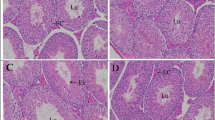Abstract
Effect of exogenous selenium at a dose of 10 μg/kg body weight on the testicular toxicity induced by nicotine in rats was investigated. Male albino rats were maintained for 60 days as follows: (1) control group (normal diet), (2) nicotine group (0.6 mg /kg body weight), (3) selenium (10 μg/kg body weight), and (4) nicotine (0.6 mg/kg body weight) + selenium (10 μg/ kg body weight). Administration of nicotine caused reduction in sperm count and sperm motility. Activity of HMG CoA reductase and concentration of cholesterol were increased in the testes of the nicotine administered group. Activities of testicular enzymes 3β hydroxysteroid dehyrogenase (3βHSD), 17β hydroxysteroid dehyrogenase (17βHSD) were decreased. Levels of testosterone in the serum were also reduced. However, the extent of these alterations was lesser in the group administered with nicotine along with selenium. Analysis of plasma revealed reduced quantity of cotinine in the group co-administered with nicotine along with selenium in comparison with the nicotine group. Nondetectable levels of nicotine were present in the co-administered group. This indicates altered metabolism of nicotine when administered along with selenium.
Similar content being viewed by others
Notes
Composition of the rat feed: The selenium content of the feed was 0.0035 μg/g, crude protein 24%, ether extract 1–3.5%, crude fiber 12%, ash 8%, calcium 1.2%, phosphorus0.06%, and nitrogen free extract 43%.
References
Barnes B, Bradley SG (1990) Planning for a healthy baby. Ebury Press, London, p 96
Briggs MH (1973) Cigarette smoking and infertility in men. Med J Aust 12:616
Evans HJ, Fletcher J, Torrance M, Hardgreave TB (1981) Sperm abnormalities and cigarette smoking. Lancet 1:627
Behne D, Weiler H, Kyriakopoulos A (1996) Effects of selenium deficiency on testicular morphology and function in rats. J Reprod Fertil 106:291
Calvin HI (1978) Selective incorporation of selenium75 into a polypeptide on the rat sperm tail. J Exp Zool 204:445
Hume CW (1972) The UFAW Handbook on the care and management of laboratory animals. Churchill Livingstone, Edinburg
Kavitharaj NK, Vijayammal PL (1999) Nicotine administration induced changes in the gonadal functions in male rats. Pharmacol 58:2
WHO laboratory manual for the examination of human semen and sperm-cervical mucus interaction, 4th ed. Pub. On behalf of WHO. Cambridge University Press, Cambridge
Folch J, Less M, Stanley GHS (1957) A simple method for the isolation and purification of total lipids from animal tissues. J Biol Chem 226:497
Abell LL, Levy BB, Brodie BB, Kendall FE (1952) A simplified method for the estimation of total cholesterol in serum and demonstration of its specificity. J Biol Chem 195:357
Rao V, Ramakrishnan S (1975) Indirect assessment of hydroxy methyl glutaryl CoA reductase activity in liver tissue. J Clin Chem 21:1523
Shivanandappa T, Venkatesh S (1997) A colorimetric assay method for 3β-hydroxy. 5. -steroid dehydrogenase. Anal Biochem 254:57
Jarabak J (1969) Soluble 17β-hydroxysteroid dehydrogenase of human placenta. In: Clayton RB (ed) Methods in enzymol, vol 15. Academic, New York, p 746
Lowry OH, Rosebrough NJ, Farr AL, Randekk RJ (1951) Protein measurement with the folin phenol reagent. J Biol Chem 193:265
Hariharan M, VanNoord T (1988) A high-performance liquid-chromatographic method for routine simultaneous determination of nicotine and cotinine in plasma. Clin Chem 34(4):724
Swathy SS, Panicker S, Indira M (2006) Effect of exogenous selenium on the testicular toxicity induced by ethanol in rats. Indian J Physiol Pharmacol 50:215–224
Williamson DF, Madans J, Anda RF et al (1991) Smoking cessation and severity of weight gain in a national cohort. N Engl J Med 324:739
Kaur P, Bansal MP (2005) Effect of selenium-induced oxidative stress on the cell kinetics in testis and reproductive ability of male mice. Nutrition 21:351–357
Shalini S, Bansal MP (2005) Role of selenium in regulation of spermatogenesis: involvement of activator protein 1. Biofactors 23:151–162
Dhingra S, Bansal MP (2006) Hypercholesterolemia and LDL receptor mRNA expression: modulation by selenium supplementation. Biometals 19:493–501
Asha GS, Indira M (2004) Combined effect of selenium and ascorbic acid on alcohol induced hyperlipidemia in male guinea pigs. Comp Biochem Physiol C Toxicol Pharmacol 137:109–114
Nassir F, Moundras C, Bayle D et al (1997) Effect of selenium deficiency on hepatic lipid and lipoprotein metabolism in the rat. Br J Nutr 78(3):493
Yeh J, Barbieri RL, Friedman AJ (1989) Nicotine and cotinine inhibit rat testis androgen biosynthesis in vitro. J Steroid Biochem 33(4A):627
Dawson EB, Evans DR, Harris WA, McGanity WJ (1999) The effect of ascorbic acid supplementation on the nicotine metabolism of smokers. Prev Med 29:451
Author information
Authors and Affiliations
Corresponding author
Rights and permissions
About this article
Cite this article
Seema, P., Swathy, S.S. & Indira, M. Protective Effect of Selenium on Nicotine-Induced Testicular Toxicity in Rats. Biol Trace Elem Res 120, 212–218 (2007). https://doi.org/10.1007/s12011-007-8021-7
Received:
Revised:
Accepted:
Published:
Issue Date:
DOI: https://doi.org/10.1007/s12011-007-8021-7




